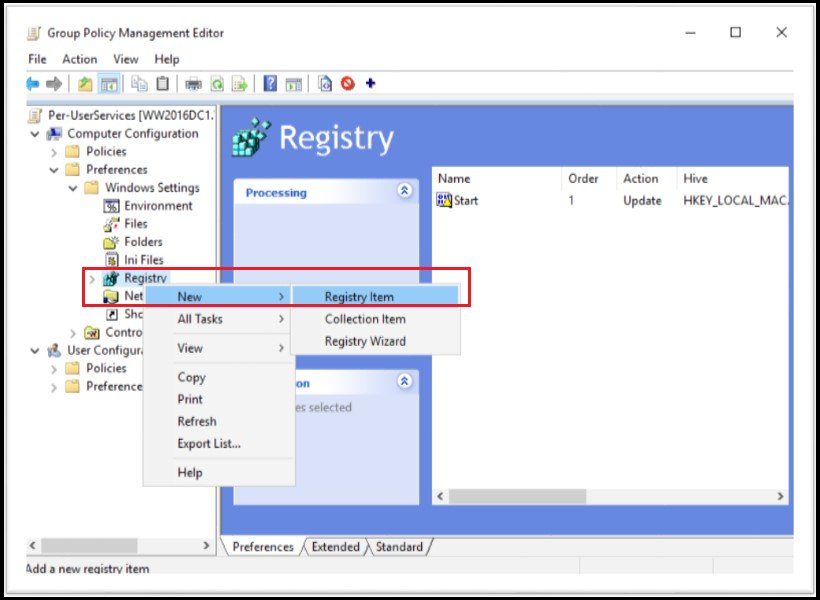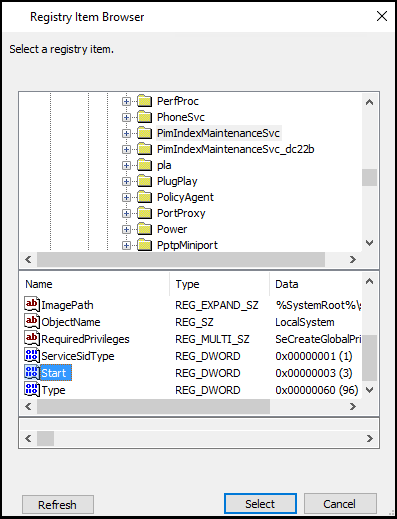Which Of The Following Services Does Windows 10 Provide
This browser is no longer supported.
Upgrade to Microsoft Edge to take advantage of the latest features, security updates, and technical support.
Per-user services in Windows 10 and Windows Server
Applies to: Windows ten, Windows Server
Per-user services are services that are created when a user signs into Windows or Windows Server and are stopped and deleted when that user signs out. These services run in the security context of the user account - this provides better resources direction than the previous approach of running these kinds of services in Explorer, associated with a preconfigured account, or as tasks.
Note
Per-user services are but in available in Windows Server if you accept installed the Desktop Experience. If you are running a Server Core or Nano Server installation, you lot won't come across these services.
You tin set the template service'southward Startup Type to Disabled to create per-user services in a stopped and disabled state.
Important
Carefully test whatever changes to the template service'due south Startup Blazon before deploying to a production environment.
Use the post-obit information to empathise per-user services, change the template service Startup Type, and manage per-user services through Grouping Policy and security templates. For more than information nearly disabling system services for Windows Server, see Guidance on disabling organization services on Windows Server with Desktop Experience.
Per-user services
The following tabular array lists per-user services and when they were added to Windows ten and Windows Server with the Desktop Experience. The template services are located in the registry at HKEY_LOCAL_MACHINE\SYSTEM\CurrentControlSet\Services.
Before you disable any of these services, review the Description column in this tabular array to understand the implications, including dependent apps that will no longer piece of work correctly.
| Windows version | Key name | Display proper name | Default start blazon | Dependencies | Description |
|---|---|---|---|---|---|
| 1803 | BcastDVRUserService | GameDVR and Broadcast User Service | Manual | Used for Game Recordings and Live Broadcasts | |
| 1803 | BluetoothUserService | Bluetooth User Support Service | Manual | Supports proper functionality of Bluetooth features relevant to each user session | |
| 1803 | CaptureService | CaptureService | Manual | OneCore Capture Service | |
| 1607 | CDPUserSvc | CDPUserSvc | Car | - Network Connection Broker - Remote Procedure Telephone call (RPC) - TCP/IP Protocol Driver | Used for Connected Devices Platform scenarios |
| 1803 | DevicePickerUserSvc | DevicePicker | Manual | Device Picker | |
| 1703 | DevicesFlowUserSvc | DevicesFlow | Manual | Device Discovery and Connecting | |
| 1703 | MessagingService | MessagingService | Manual | Service supporting text messaging and related functionality | |
| 1607 | OneSyncSvc | Sync Host | Auto (delayed) | Synchronizes mail service, contacts, calendar, and other user data. Post and other applications dependent on this service don't work correctly when this service is not running. | |
| 1607 | PimIndexMaintenanceSvc | Contact Information | Manual | UnistoreSvc | Indexes contact data for fast contact searching. If you stop or disable this service, search results might non display all contacts. |
| 1709 | PrintWorkflowUserSvc | PrintWorkflow | Manual | Print Workflow | |
| 1607 | UnistoreSvc | User Data Storage | Manual | Handles storage of structured user information, including contact info, calendars, and messages. If you end or disable this service, apps that use this data might not work correctly. | |
| 1607 | UserDataSvc | User Data Access | Manual | UnistoreSvc | Provides apps admission to structured user data, including contact info, calendars, and letters. If you finish or disable this service, apps that use this data might non work correctly. |
| 1607 | WpnUserService | Windows Push Notifications User Service | Manual | Hosts Windows notification platform, which provides support for local and push notifications. Supported notifications are tile, toast, and raw. |
Disable per-user services
The template service isn't displayed in the Services console (services.msc) so you need to edit the registry directly, either with Group Policy or a scripted solution, to disable a per-user service.
Annotation
Disabling a per-user service but ways that information technology is created in a stopped and disabled state. When the user signs out, the per-user service is removed.
You can't manage all of the per-user service templates services using normal Group Policy management methods. Because the per-user services aren't displayed in the Services management console, they're also not displayed in the Group Policy Services policy editor UI.
Additionally, at that place are iv template services that tin't be managed with a security template:
- PimIndexMaintenanceSvc
- UnistoreSvc
- UserDataSvc
- WpnUserService
In light of these restrictions, you tin can use the following methods to manage per-user services template services:
- A combination of a security template and a script or Group Policy preferences registry policy
- Group Policy preferences for all of the services
- A script for all of the services
Manage template services using a security template
You tin manage the CDPUserSvc and OneSyncSvc per-user services with a security template. Encounter Administer security policy settings for more data.
For example:
[Unicode] Unicode=yes [Version] signature="$CHICAGO$" Revision=1 [Service General Setting] "CDPUserSVC".4,"" Manage template services using Grouping Policy preferences
If a per-user service tin can't be disabled using a the security template, you can disable it by using Group Policy preferences.
-
On a Windows Server domain controller or Windows 10 PC that has the Remote Server Administration Tools (RSAT) installed, click Start, type GPMC.MSC, and then printing Enter to open the Group Policy Management Console.
-
Create a new Group Policy Object (GPO) or use an existing GPO.
-
Right-click the GPO and click Edit to launch the Grouping Policy Object Editor.
-
Depending on how y'all want to target the Group Policy, under Computer configuration or User configuration browse to Preferences\Windows Settings\Registry.
-
Correct-click Registry > New > Registry Item.

-
Brand certain that HKEY_Local_Machine is selected for Hive and and so click ... (the ellipses) side by side to Key Path.

-
Browse to System\CurrentControlSet\Services\PimIndexMaintenanceSvc. In the listing of values, highlight Start and click Select.

-
Change Value data from 00000003 to 00000004 and click OK. Note setting the Value data to four = Disabled.

-
To add the other services that cannot exist managed with a Group Policy templates, edit the policy and repeat steps 5-8.
Managing Template Services with reg.exe
If you cannot use Group Policy Preferences to manage the per-user services, you can edit the registry with reg.exe. To disable the Template Services, alter the Startup Type for each service to 4 (disabled). For example:
REG.EXE Add together HKLM\System\CurrentControlSet\Services\CDPUserSvc /v Start /t REG_DWORD /d four /f REG.EXE ADD HKLM\System\CurrentControlSet\Services\OneSyncSvc /v Start /t REG_DWORD /d iv /f REG.EXE ADD HKLM\System\CurrentControlSet\Services\PimIndexMaintenanceSvc /v Start /t REG_DWORD /d 4 /f REG.EXE ADD HKLM\Organisation\CurrentControlSet\Services\UnistoreSvc /five Start /t REG_DWORD /d 4 /f REG.EXE Add HKLM\System\CurrentControlSet\Services\UserDataSvc /five Kickoff /t REG_DWORD /d 4 /f REG.EXE ADD HKLM\Arrangement\CurrentControlSet\Services\WpnUserService /v Start /t REG_DWORD /d 4 /f Circumspection
We recommend that you do not directly edit the registry unless at that place is no other alternative. Modifications to the registry are not validated past the Registry Editor or by the Windows operating system before they are applied. As a result, incorrect values can be stored, and this can effect in unrecoverable errors in the organization. When possible, instead of editing the registry direct, use Grouping Policy or other Windows tools such every bit the Microsoft Management Console (MMC) to attain tasks. If you must edit the registry, use extreme caution.
Managing Template Services with regedit.exe
If you lot cannot use Group Policy preferences to manage the per-user services, you tin edit the registry with regedit.exe. To disable the template services, change the Startup Type for each service to four (disabled):

Caution
We recommend that you do not directly edit the registry unless there is no other alternative. Modifications to the registry are not validated by the Registry Editor or past the Windows operating organisation earlier they are applied. As a result, incorrect values tin can be stored, and this can result in unrecoverable errors in the organization. When possible, instead of editing the registry directly, utilize Group Policy or other Windows tools such as the Microsoft Management Console (MMC) to attain tasks. If you lot must edit the registry, use extreme caution.
Beginning with Windows x, version 1709 and Windows Server, version 1709, y'all can prevent the per-user service from being created by setting UserServiceFlags to 0 under the same service configuration in the registry:

Manage template services by modifying the Windows image
If you're using custom images to deploy Windows, you tin change the Startup Type for the template services as part of the normal imaging process.
Utilize a script to manage per-user services
You can create a script to change the Startup Type for the per-user services. And so use Group Policy or another management solution to deploy the script in your environment.
Sample script using sc.exe:
sc.exe configure <service proper name> start= disabled Note that the space later "=" is intentional.
Sample script using the Set-Service PowerShell cmdlet:
Set-Service <service name> -StartupType Disabled View per-user services in the Services panel (services.msc)
As mentioned you tin't view the template services in the Services console, but yous can see the user-specific per-user services - they are displayed using the <service proper name>_LUID format (where LUID is the locally unique identifier).
For case, you might encounter the following per-user services listed in the Services console:
- CPDUserSVC_443f50
- ContactData_443f50
- Sync Host_443f50
- User Data Access_443f50
- User Information Storage_443f50
View per-user services from the command line
Y'all can query the service configuration from the control line. The Type value indicates whether the service is a user-service template or user-service case.

Source: https://docs.microsoft.com/en-us/windows/application-management/per-user-services-in-windows
Posted by: pressleyolawkway.blogspot.com


0 Response to "Which Of The Following Services Does Windows 10 Provide"
Post a Comment